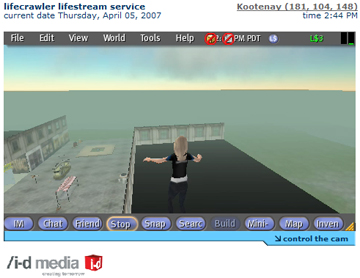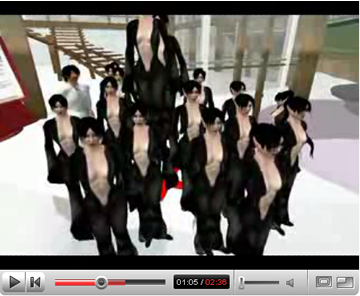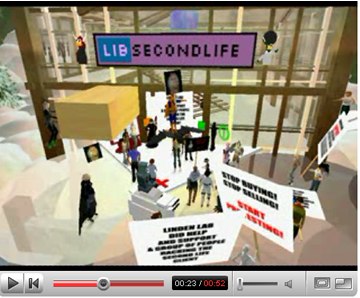June 22, 2007
Will Web 2.0 Kill Cyberspace?
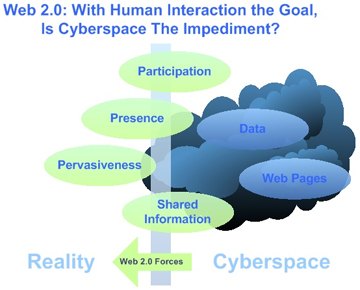
"[...] These days the boundaries between reality and cyberspace are becoming increasingly blurred and the activities on the Web are becoming more two way and integrated with reality ... With going into cyberspace no longer being a discrete step (folks are more and more always there now) and with the primary activity often being to interact with other folks transparently, and you have a folding of cyberspace so severe that it just disappears into the ether." From Will Web 2.0 Kill Cyberspace? by Dion Hinchcliffe.
Posted by jo at 09:45 AM | Comments (0)
April 05, 2007
Second Life Flood
An immersive demonstration of global warming's worst case scenario impact-- whole regions throughout Second Life, submerged under water. [via]
Posted by jo at 06:45 PM | Comments (0)
lifecrawler lifestream service
Bring secondlife presence on your website. Increase your coverage of your secondlife events by streaming your outstanding performance realtime to the internet.
Posted by jo at 05:51 PM | Comments (0)
March 25, 2007
NOEMA

Ideas + Survey
Generic Infrastructures [2] by Rob van Kranenburg: Today we are in the worst situation imaginable. Our global and undisputed computing paradigm posits that computing processes are successful only in as much as they disappear from view. Our design focus is ever more following Philips untenable but seductive ‘sense and simplicity’ resulting in the-bug-as-a-feature-design of the Ipod Shuffle. Our educational system is following this systemic hide-complexity strategy that favors the large industrial labs, IT conglomerates and above all their clinging to notions of IP and the patent that are firmy tied to their notions of doing business and making money. And our users, us? We are YOU, the most influential person of the year 2006, according to TIME Magazine. You fill the Wikipedia entries in your spare time, you blog your daily activities, you co-bookmark on de.l.i.c.i.o.u.s, upload your photos to flickr, you buy mating gear in Second Life, and mark your position on Plazer or Google Earth. You fill out the forms. Isn’t it time you start questioning the principles behind the formats? And, to make matters even worse, your naïve ideas of sharing are corrupting notions of privacy, transparency and informational architecture symmetry.

Ludium II - Synthetic Worlds and Public Policy by Edward Castronova: Synthetic worlds – million-player online environments with genuine markets, societies, and cultures – are exploding in size and significance. Real world governments around the globe are beginning to grapple with their implications in the areas of taxation, intellectual property laws, consumer rights, addiction, violence, and more. Should synthetic worlds be controlled by developers, or by governments, or both? What about the rights of users? What general norms should legislatures and courts follow? More NOEMA >>
Posted by jo at 01:33 PM | Comments (0)
March 08, 2007
Second Life Sketches: Let’s Put The Future Behind Us

We show where we came from
"[...] Philip Rosedale, founder of Linden Labs, started from the simple what-if question that seeds all of science fiction: what if we could actually invent this? ... To a generation of early adopters raised on Gibson and Stephenson, the answer was obvious. We show where we came from.
And so there’s a region called Gibson, upon which there is a city called Nexus Prime. It’s a cyberpunk set, a city deep and wide and styled as the paleo-future of the 1980s. You start on a high city square, surrounded by the gleaming spires of zaibatsu skyscrapers. Descend, and you’ll find the wrecked streets, the Gothic churches and blood-bucket bars. Under the streets are tunnels, leading to illicit clinics and bombed-out labs.
[...] As Gibson and Sterling wrote The Difference Engine, so too did Stephenson write The Diamond Age, his own take on the antique-styled future subgenre called steampunk. And so, as there is Gibson and Suffugium and Saijo City, so there is Caledon, the state of regions devoted to neo-Victorian style. In addition, a region called Babbage appears to be currently under construction in the same style ..." From Second Life Sketches: Let’s Put The Future Behind Us by Warren Ellis.
Posted by jo at 11:40 AM | Comments (0)
March 06, 2007
[iDC] The -L- Word
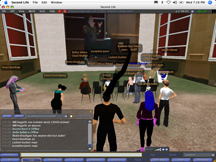
Laboring + Learning in Second Life
[left: Trebor Scholz presenting at OurFloatingPoints on Emerson Island, SL; screenshot by John Craig Freeman, February 28, 2007.]
Trebor Scholz wrote: After the OurFloatingPoints event at Emerson College, over some green string beans and tofu, I talked with the organizers about the value of Emerson buying an island in SecondLife (SL) for a thousand dollars in order to build a representation of their First Life campus. (Monthly service costs are about $250.) I still don't quite get it.
Emerson and Harvard replicated their First World architecture in SL. [1] SecondLife simply becomes a novel Public Relations interface. By re-creating our existing institutions in the virtual world, we loose a chance to re-think these knowledge factories untied from the restrictions of economical restrictions. Nevertheless, Harvard's Berkman Center for Internet & Society uses their SL campus to offer courses open to the "public" and Emerson even experiments with 3D modeling classes and authors artworks.
Berkman's use of its campus for long-distance learning ("courses open to the 'public'") is not interesting for me as there are only few examples of this kind of "e.learning" that made sense to me. Years ago, I used to take classes into Habbo Hotel in order for the students to get to know each other in this environment. That worked well, but why do we need to buy our own turf? Why do we need a replication of our own campus? Why not rather build a Black Mountain College with a Bauhaus Annex? Why teach in this virtual environment? Will SecondLife become a 3D version of Wikipedia, a virtual knowledge bank that offers a playful and fun interface to participant-generated content? Will students simply demand such playful access to knowledge?
Josephine Dorado's Kids Connect project nicely illustrates some affordances of SL. [2] Avatars add a bit of social bandwidth and I respect Josephine's argument that SL offers a sense of connectedness that is hard to measure. Brian Holmes warns us that many fantasy scenarios are "deeply instrumentalized, and most often in the service of powerful agendas, put into effect by groups which have the ability to manipulate the basic parameters of our environments, be they 'virtual' or 'actual.'" I agree; the biggest problem with SL is that it is a proprietary space.
The creative *labor* of the very very many financially benefits the very few. Monetary value is created in many ways (mere presence à la attention economy, creation of profiles, production of 3D objects, import of media content). Labor, with the Italian philosopher Paolo Virno, has become performance, the act of being a speaker. Labor is tied to speech acts and communication systems. [3] To paraphrase the old saying: The greatest trick that capital ever pulled was convincing the world that labor didn't exist. Labor, with most physical production work (except service, of course) now moved to the global south, becomes a "casualized," often distributed, immaterial activity that is even mistaken as leisure or plain "fun." It took peoplea while to realize that online architectures reflect the political post-Fordist structures of First Life. In 1992, for example, Digitale Stad was set up with the idea to "design a complex, multi-layered system that operates largely on the basis of the city metaphor." The experiment did not work out.
Today, online architectures do not just simply mirror "First Life Capitalism," but the absence of awareness of servitude* is radically new. The Frankfurt School philosopher Herbert Marcuse put it well: "All liberation depends on the consciousness of servitude." This holds more true today than ever; many people in the US actually think that they are "happy" and perceive this distributed labor of the sociable web as a fun leisure activity. "We would do it anyway." The community becomes the product. I opened up these questions at Emerson--
"(Un)ethical Capitalism and Sociable Web Media" (video cast, download m4b file, 11.4mb-- open in Quicktime, resize, duration: 40 minutes) http://www.molodiez.org/podcasts/episode_20070301_203115-0500.m4b
What do YOU think about the exploitation of labor in sociable web media and virtual worlds in particular? Are there alternatives? Already after a short look at the demo of Solipsis, "the pure peer-to-peer system for a massively shared virtual world" (and potential alternative to SL), it seemed rather disturbing in terms of its US-centrism. [4]
I imagine SecondLife, currently in its early stages, as a useful place for a kind of rapid prototyping also in activist contexts. On the other hand, there is the danger that Second Life could just become a valve for social tension that should rather be played out in First Life, I partially agree with Charlie Gere. (A virtual speakers corner.) SL is ecologically harmful, I welcomed Julian Bleeker's reminder that there is no Second Life without the materiality/resources of First Life. Giselle Beiguelman points to the cinematic "observation of the second order,” with the avatar a step removed from us. This site could be a liberating place for experimentation with identity. What SL will be, remains to be seen; for now it requires the same kind of skill set that other participatory cultures call for; a toolbox that allows us to handle these environments in a way that serves our best interests and is aligned with our values and aspirations.
TS
[1] Harvard's Berkman Center in SL
http://www.flickr.com/photos/tonz/238309925/
[2] Kids Connect Project
http://flickr.com/photo_zoom.gne?id=198239256&context=set-72157594204191164&size=l
[3] http://www.generation-online.org/p/pvirno.htm
[4] Solipsis
http://solipsis.netofpeers.net/wiki2/index.php/Main_Page
Eric Gordon wrote:
As one of the organizers of OurFloatingPoints at Emerson and as one of the people behind designing our Second Life campus, I have to say a few things about our intentions, and more broadly speaking, about the possibilities of SL for education. First, I find it difficult to speak of Second Life as if it possessed some innate qualities. That's like saying the Web "fosters community" or "collapses geography." Blanket statements about a platform are necessarily limited to stereotypical characteristics and leave little room for technological adaptation to social formations. That said, Second Life is neither the next big thing or dangerous for our educational goals -- however, it is a novel platform through which we can explore questions of presence, place, community, and exhibition.
Emerson College is an urban campus that hugs the southeast corner of the Boston Common. The geography of Boston is important to the experience of being on campus. Therefore, our decision to reproduce the architectural layout of campus and to recreate the Boston Common was deliberately made to correspond with our understanding of the platform's possibilities. We see Second Life as a way of creatively re-imagining the space. While, we're not able to screen student work in the physical Boston Common, it will be possible to do so in Second Life. While it is not possible to hold a meeting outside in January, it will be possible in Second Life. The virtual campus is not a fantastical space, but an enhanced space that can dialogue with the physical space. I don't see Second Life as a replacement for the classroom, the live event, the campus, or even the heart of Boston, but as an addendum to our existing arsenal of lived experiences. One of the most interesting aspects of the SL platform is how people identify with places and create a sense of the familiar. Whether this is through representations of institutions, geography, or products, familiarity and co-presence are potential qualities of the platform that deserve attention. Our efforts are not, as Trebor suggests, a marketing tactic for the school. While the administration's support for our efforts are certainly driven by those considerations, they understand that this is a faculty and student research project intended to investigate the possibilities and limitations of the environment.
The first element of our build is the theater wherein we hold live events. The question of how to orchestrate a live event in Second Life has been the topic of much internal debate. Primarily, can the Second LIfe audience, projected onto the screen during the event enhance the experience of those physically present? What can the corresponding audience of avatars (composed of proximate and non-proximate users) offer to the live audience? Is there a method of interaction between the two audience sets that would best activate
the audience? Can we use the platform to change the relationship between speaker and audience? Can we use the platform to alter the format of speech followed by questions? Again, we don't know the answer to these things, nor do we assume that Second Life supplies the answers. But we're excited to place a virtual scaffolding around what has become normalized academic practice in order to replace, repair or simply protect what we already know.
Eric
Ana Valdez wrote:
That's really interesting and I really wish more researchers could be engaged in the studio of Second Life's conditions and behaviours. A world without democracy, where the individual is constricted to "mature contempt" islands, where the discussion made in official forums is controlled by the omnipotent and omniscent Linden Lab. I read the headlines from last week's turbulence in SL. "terrorist attack in Second Life", "cyberterrorism". What is virtual terrorism? It reminds me about Julian Dibbell's excellent book "My tiny life", where a virtual rape was discussed and put on trial. And about precariety and workers rights we should discuss Anshe Chung, the real estate broker avatar for Ailin Graef, is known to use workers from her nativev China to make virtual wares in places similar to sweatshops. Virtual sweatshops are also used for games as Everquest or Ultima Online, where macros can be used to generate or reproduce objects who can be sold or traded in the games or outside the games. The virtual sweatshops (or more clear, the real sweatshops) are in the real life and populates av real workers, they make virtual wares but they are treated as all other precarious workers: they work day and night in dangerous conditions, exposed to datasmog and radiation of the screens. Many of them are in the maquila zone between Mexico and the US, Graafs are in China.
Ana
Michel Bauwens wrote:
Hi Trebor,
For years, the left has complained about the stranglehold of mass media, and how they were dumbing us down, preventing autonomy and sharing etc...
Now we have an extraordinary techno-social development which creates a multitude of micromedia, some of which, most of which?, probably are mediated by an existing political economy and specifically in concrete cases by proprietary platforms.
But the first thing is to recognize the joy that people are feeling when they are enabled/empowered to express themselves, share, and form communities. On that basis, they will learn the impediments that mediation is forcing on them, and learn to yearn for more pure forms of autonomy.
However, if peer production is non-reciprocal, as I argue, then it makes no sense to argue about exploitation through derivative services.
Rather, I would argue that in most cases, there is a very well understood social contract. You provide us with a participatory platform, we understand that needs funding, and therefore, the provider has a business strategy. Conflicts will arise out of the balance between participation and profit-taking, but not on the very principle of profit taking ,since this is the very condition for the participatory platform to be sustainable. If the participation breaks down because of the profit taking, as seems the case in MySpace, then people start to leave, and eventually, the social conditions for the creation of totally autonomous platforms will arise.
I understand that in academia, being critical is the life-blood for recognition and that there is a competition towards hyper-criticality. But I think that the conclusion that most people have suddently become 'dumb', because they do not recognize the exploitation, is unwarranted. They do know this, and they mostly recognize it as a fact of life, but they also have their own interests at heart.
If you criticize that the benefits of the labor of the many go to the few, does that then imply that you favour revenue-sharing? But in that case, you kill passionate production, it becomes a for-market activity, the quality of contributions plummets. Is that what is preferable? Or rather, should we find ways so that the generated revenue goes back to the community in such a way that the peer production process is not undermined by direct payments?
I say we need strategies which work with the passion of the peer producers, that take them seriously (does not assume they are dumb and unaware of exploitation).
Michel
Patrick Lichty wrote:
As mentioned before, I'm not totally convinced about the whole L thing, but it seems to be my area of research, and where I seem to be located.
And as new Columbia College island admin, I made a few decisions.
First, admissions asked if we could do a reconstruction of the campus.
Personally, I don't understand this. It's very odd that human architecture remains in a space where you can fly, etc.
My vision for the Columbia site is a place for experimentation, live media streaming, and for information dissemination to prospective students and existing ones. My department teaches 3D modelin and game design, and it makes sense for us to use Sl at this time, and better to put the fine artists in charge ;)
Therefore, no virtual representation of the physical campus. Period.
However, I intend to have galleries for our annual festival, links to departments and information, virtual t-shirts, departmental sandboxes, and media servers. Hopefully, our architecture will depend more on small textures than geometry, like Emily Carr. That way, we can look at basics of form, and concentrate on function.
Makes no sense to duplicate the physical in the virtual, although a lot of the rules are similar, many others are totally different.
Patrick
Trebor Scholz wrote:
Michel,
The dynamics of labor are complex. It's complicated; participants in sociable web media surely get something out of their time spent and labor invested. (I really appreciated the link that Ana Valdes established between virtual and "real life world" exploitation.) But when you say that people are aware that they are unfairly treated, I suggest to geographically situate this argument. Speaking about far stretches of Europe, I agree with you that such awareness is prevalent. Within the context of the United States, however, I can assure you that it is not some kind of opportunistic ivory tower assertion to propose that the consciousness of the very real exploitation of labor is dismal among the youth. Talk to most of the 18 or 25 year-olds here and you will find very little of the awareness that you are taking for granted. Au Contraire! I noticed a naturalized identification with corporate interests that seem to be closer to their hearts than their own. This is not their "fault," it's not the wrong kind of youth -- it is simply the way they were socialized, --yes-- by the mass media and basically by everything that surrounds them since day 1. Many of them see exploitation as a phenomenon that transcends history and is part of human nature. Sure, it is costly to provide the kind of service that MySpace or YouTube provide (granted that these are extreme examples). However, there is an undeniable imbalance between the profit gained through the performance and speech acts of the very many participants and their payback (micro-fame, affect, a sense of belonging, ...). And, there is nothing natural about that.
Trebor
Joshua Levy wrote:
In the push-pull between the market and expression, many people here and elsewhere in academia tend to take sides against the market as if the market is in itself exploitative, and entrepreneurship should be discouraged, and anything that smells of profit is suspect. I'm not so ready to make those conclusions about SL or other for-profit environments since, as Michel argues, most users comprehend and accept the plain fact that the principle of profit-taking is "the very condition for the participatory platform to be sustainable." Is this a perfect model for free expression? Maybe or maybe not. But how else are we going to fund a platform like SL that takes real human sweat (alas, maybe produced in virtual sweatshops) to stay afloat and innovate. We can dream about a full open source SL, and that may happen some day, but there's no crime in Linden Labs' profit motives alone.
Our entire electronic life involves this contract: Google and all of its services are free to us because of the advertising Google rakes in; this may not be "pure" but it works -- Google is at the top of its field and the geeks prefer it. We watch television for free in return for watching inane commercials, etc. Is this system perfect? No. But that doesn't mean it's exploitative. As Michel says, if a company like MySpace overreaches is authority, we can leave and set up camp somewhere else.
-Josh
Simon Biggs wrote:
A very short contribution to what is a very complex issue.
It seems to me that in its very conception SL is a replication of the dominant socio-economic mode of our time, the late-capitalist model developed primarily (although not entirely) in the USA and its satelites. SL has developed from and within the apparatus of globalised capital. That the ethical systems that underpin such an ideology are then found to be those that determine how SL develops should not be surprising. That money even exists in SL provides sufficient evidence of this.
SL is a misnomer. It is not a second life but simply a kind of first life, as constructed by a dominant elite, represented in such a manner that it will function to further inculcate and embed its associated ideology on a global scale. It will sustain the fundamental ethic of consumerism...that we are all potential suckers or grifters (often both) and that nobody is responsible for what happens to anybody else. In short, it is another rip off culture.
Regards,
Simon
Andreas Schiffler wrote:
Michel Bauwens wrote:
> I say we need strategies which work with the passion of the peer
> producers, that take them seriously (does not assume they are dumb and
> unaware of exploitation).
In response to this very good analysis, I want to throw in an comment about the technology dependence of these strategies (aka, I am a technologist and can respond best in those categories).
What has arguably worked best in the past are systems that require a minimum of technology for the individual participant - allowing them to "plug in" easily. A good example is Wikipedia. Wikipedia allowed people to contribute with "just a browser" - even the text based "lynx" browser works. What's more, the interface was designed so that one didn't even have the hurdle of "logging in" - just click the [Edit] button and type. The servers and software that run Wikipedia were similarly "minimal" at the onset and only needed to be expanded when traffic grew due to the popularitly (see http://meta.wikimedia.org/wiki/Wikimedia_servers and http://en.wikipedia.org/wiki/History_of_Wikipedia).
Going back to the strategy argument: the simple fact that a system such as "Wikipedia" can run with these relatively modest hardware requirements helps greatly to keep the system operational through individual support and donations only - thus keeping it a relatively "corporate and ad-free" zone. Currently the Wikipedia system is run on about 100+ machines which are mostly caches. Now if we compare that to the 4000+ machines of SecondLife mentioned on previous threads - about 20 times more - it is easy to see why a system like SL is only viable in a "for-profit" scenario.
One conclusion that one can draw from this observation, is that systems operating at the high-end of technological capability such as SL are not very viable to be open (although that can change over time, as technology becomes better). This is similar to and extends the arguments about our digital divide: access to the Internet requires a certain amount of $ leaving behind the part of the world that has only 2cents. Access to a Virtual World requires requires even more $$$ further skewing the economics of "free and participatory".
Getting back to a strategy: What has to happen to facilitate a truly open virtual world? I think is likely best done as a massively connected distributed-computing system - a fragmented amorphous "Matrix" with minimal central server requirements similar to some of the P2P networks in existence today.
I could envision an open collaborative effort where participants contribute not just give their "labor" and their presence but also some bits and bytes form their harddrive, the idle CPU cycles of their screensavers and some connectivity to provide the resources that make up the VR in the first place. Thus what would be needed is a software that allows participants to contribute "Micro-Matrices" to the whole pool. I could see this being build out of existing OpenSource software; Linux as the base to get the hardware to go, building on networking technologies such as BitTorrent and Tor (http://tor.freehaven.net/), enabling grid computing similar to distributed.net, adding creative tools such as Gimp and Blender, supporting existing document technologies via OpenOffice like apps, providing communications via HTML, JXTA (http://vop2p.jxta.org/), H.264 and Jabber protocols.
Such a software might actually challenge the "Operating System + Deskop" metaphor sold by Microsoft and Apple. What if operating a PC means actually "plugging into a virtual world" in an equally give-and-take manner. If this would take hold, it might help free the Internet from the stranglehold of the "Asymmetric Digital Subscriber Line" (ADSL) economy: the A means that most current broadband connections are too slow for uploads, disallowing individuals to operate servers effectively from home, hence inhibiting technologies such as the ones described above.
While at this point in time such a software or developments are more Fiction than Science, keep in mind that Nintendo is probably working on it. ;-)
Andreas
Trebor wrote:
Howard Rheingold on on Education in SL:
"I've lectured in Second Life, complete with slides, and remarked that I didn't really see the advantage of doing it in SL. Members of the audience pointed out that it enabled people from all over the world to participate and to chat with each other while listening to my voice and watching my slides; again, you don't need an immersive graphical simulation world to do that.
I think the real proof of SL as an educational medium with unique affordances would come into play if an architecture class was able to hold sessions within scale models of the buildings they are studying, if a biochemistry class could manipulate realistic scale-model simulations of protein molecules, or if any kind of lesson involving 3D objects or environments could effectively simulate the behaviors of those objects or the visual-auditory experience of navigating those environments. Just as the techniques of teleoperation that emerged from the first days of VR ended up as valuable components of laparascopic surgery, we might see some surprise spinoffs in the educational arena. A problem there, of course, is that education systems suffer from a great deal more than a lack of immersive environments. I'm not ready to write off the educational potential of SL, although, as noted, the importance of that potential should be seen in context. In this regard, we're still in the early days of the medium, similar to cinema in the days when filmmakers nailed a camera tripod to a stage and filmed a play; SL needs D.W. Griffiths to come along and invent the equivalent of close-ups, montage, etc.
The one difficult to surmount obstacle is the learning curve. One figure I'd like to see is the number of people who create objects and environments in SL. That population is where the innovations are likely to emerge.
I think the SL hype deserves debunking, but let's not set that debunking up as an eternal straw man. Who, exactly, is predicting that any percentage of the population will really live in SL? (Someone who has lost a loved one to WOW?) To me, the point has long since ceased to be whether or not this is going to be as popular as solitaire, but whether some truly useful innovation is going to emerge."
Alan Clinton wrote:
I find Trebor's concepts of "unpaid labor" and his seeming desire to convert every act into "labor" somewhat problematic. I am also concerned about the philosophical ramifications of saying that people who think they are having fun are not really having fun or experiencing pleasure.
I'm not sure that seeking out all the unpaid labor in the virtual world is the most productive critique of capitalism.
Is the greatest trick of capitalism really convincing people that labor doesn't exist? I would say that its greatest trick would be convincing people that the violence of human exploitation doesn't exist. At the risk of revising Marcuse, couldn't we say that consciousness of servitude is not really the problem so much as providing strategies for political agency? People who are laboring know that they are laboring. People (and let's not dismiss the global south so quickly) who are suffering the violence of capitalism know they are suffering the violence of servitude. They may lack awareness of ways to name this violence or attack it, but they are not unaware of their suffering.
It's hard for me to shed any real tears for socioeconomically stable people giving up their virtual labor (or false consciousness fun) to companies that profit from it. However, it is criminal if sociable media agents/interfaces sap these individuals, as embodied beings, of the time, energy, and knowledge required for political agency (not primarily for themselves but for the brutally exploited)--having their political agency diminished or extinguished by their lack of awareness of their participation in the violent capitalism of which they are, for the most part, beneficiaries.
Perhaps the surplus value that needs to be spoken of in this context is the time, resources, and knowledge that is diverted from potential actions against global capitalism and its violence.
Alan Clinton
Tobias van Veen wrote:
Thanks Charlie for your wonderful critical blasts of SL scholarship.
However I do find it intriguing, this constant parallel with masturbation, insofar as it is part of a long, funny history in philosophy of guilt and denial and apology and moralism over masturbation (pinpointed with such acuity and humour in Derrida's analysis of auto-affection and "that dangerous supplement" in Rousseau, Of Grammatology).
The point being that masturbation, aka simulacra of sex, is as REAL as "real sex", it is not derived from real sex and thus a derivation or perversion, it is just sex with one's other-hand, it already entails alterity -- there is no need to debase it, is there? Thus to charge SL, even as polemic, with "cultural pornography" in this case I think is to offend pornography, not SL. Why degrade pornography and masturbation? Condemning sexual activities online is yet another facet of the "Bush administration" as you put it, and I think one of the more complex analyses yet to be grasped is the complex relation all online realms hold between sexuality, affect (aka masturbation) and alterity. It's what them younger kids are up too.
As for SL, Upgrade International has just launched a node there. So has Dorkbot from what I hear. Our current debate (I curate UpgradeMTL) is trying to find where to put it on our Google worldMap. Some suggest in the North Pole or middle of the Pacific; others, a random location to be loaded each time; others, where the servers are located.
I find this intriguing, the concept of a media arts meeting online, once a month, like the other Upgrade flesh gatherings, each based in its own city, in the sense that our avatars can get together in some virtual space and watch media clips of someone's media art, txt chat about it, ask questions, and that this might flit over all those nation-state barriers, save for that odd one concerning the curvature of the planetoid and that time thing. But it is interesting in the way that television can be interesting, maybe up a notch to some kind of participatory level, through the screen, always bounded by this screen. It might even be that such meetings are really the "proper" place of such media art, and not in the flesh, this nonplace, nonproper, properly speaking. Perhaps the rest of us city-based nodes are hanging on to some outdated mode of the f2f -- many of us struggling to make it work on a regular basis, the perennial question, "where is the community?" -- while SL demonstrates where media art finds its chez moi. Toward nonmedia, uncanny nonplace of the screen medium, technics hyperdrive on affect overload. I'm not sure if this is where my body wants to go though... which is really nowhere, just my chair, the same one I've been at all day. Now if Upgrade-I started having SL orgies, perhaps this would up the interest meter a notch, it would keep one hand busy at least, maybe even two... and if my partner were involved, would this classify as real sex, a partial threesome, the third the screen / webcam interface? Hmm.
Keep the fire comin'.
best,
tobias
Charlie Gere wrote:
Tobias
Thanks for your thoughts and believe me I am the last person to condemn masturbation, and therefore I take your point about denigrating pornography etc... I fear my polemical zeal and weakness for a beguiling metaphor overcame my capacity to present a fully reasoned argument. My point was about the dangers of conflating two different things, the experience of a virtual space such as SL on the one hand, and that of RL communities on the other. It's not really a question of embodiment; after all, as Benedict Anderson pointed out all those years ago, most of our communities are imagined and don't involve experience of all the other bodies of which they are comprised. But I do think it is a question of what actual effects actions have in different realms, such as SL and RL, and what kinds of responsibilities they bring with them.
I teach my Cultural Studies undergraduate students a couple of texts that relate to these issues, 'The Cross-Dressing Psychiatrist' by Allucquere Rosanne Stone and 'A Rape in Cyberspace' by Julian Dibble. Though both predate SL by quite a few years, the questions they raise remain pertinent, particularly the Dibble piece. My students and I have long discussions about whether the virtual textual 'rape' enacted on an avatar in LamdaMoo is in any sense equivalent to rape as the term is used in the material world. (Interesting that, as Tobias may well point out, that rape as an example confirms the 'complex relation all online realms hold between sexuality, affect... and alterity'). My strong sense is that there is pretty much no comparison and to conflate the two uses of the term is dangerous and even offensive. As a thought experience, imagine a rape victim's possible reaction to hearing someone describe some experience in SL as 'rape'. By the same token this could be said of many other terms used in both SL and RL, and of the experiences and structures to which they refer. Again imagine the reaction of someone who has been involved in attempting to build and sustain communities in, for example, Iraq or Palestine, listening to someone describe the problems of community building in SL. I think grasping and holding onto this distinction is incredibly important.
Charlie
Josh Levy wrote:
I had a minor breakthrough last night. Some of the more experienced SL folks here are going to laugh at me for this -- but I realized that you can do so many more things with the camera than I realized (the camera is your POV in Second Life). It can be manipulated as you go about your business there, panning left to right, moving up and down, and zooming in and out. Previously I'd only zoomed in and out, struggling to focus in on other avatars' faces, or -- because I'm recording this for a short film -- to position my own avatar in visually interesting ways, including actually looking at my own face. Anyway, I felt a bit schmucky about it because I realized I should have known how to do this all along.
After I finished flogging myself I investigated Camp Darfur in SL. It's changed a lot since I've last been there, though the lack of other avatars is the same. Before it was pretty empty, with information scattered here and there and a few banners publichzing the atrocity. Now, there are flames leaping out at you as you arrive, posters describing the tragedy and images of refugees all over the place, and ominous-looking, giant blue helmets (the UN, get it?) strewn about. It's a pretty chaotic place, though this chaos doesn't suggest man-made terror as much as a lack of design and forethought.
I was struck by the same incongruities that got me interested in SL in the first place, the simple problem of confronting real issues in an unreal space. It sounds mundane and obvious when describing it, yet the feelings evoked by seeing my avatar -- or being my avatar -- standing in front of a large image of a Darfurian child, dirty and alone and crying, were complex and new. The child in the image was approximately the same size as my avatar. The two images existed in the same space, and were both representations of real people, yet my avatar was a digitized version of myself, and the image of the child was simply an image of the child. There were no other avatars around so I couldn't experience the thrill of social life in SL, and this fact heightened the starkness of the image. As I walked around I inadvertently created more of these tableaus. In one, my avatar looked at a poster with mostly words on it. As the camera panned around to the left side of the avatar its profile took up the foreground of the shot. In the background appeared an image of a woman from Darfur. In the distance were virtual huts with more information inside them and other tiny images. The image privileged my virtual face and relegated someone's real, distraught face to the background.
Gazing upon this image made me think of what many people on this list have referred to, that Second Life is the province of an educated elite and as such is given a disproportionate amount of importance with many tragic aspects of real life taking a back seat. More than anything else, it felt perverted that I should be in Second Life looking at those images taken of real women and children while my avatar and I practiced camera moves.
Yet there was something else going on; I was moved to stop and think about these things rather than see an image like that and pass it by without noticing, which is more typical. In her book Regarding the Pain of Others, Susan Sontag takes a sort of potshot at her earlier self, arguing that images in themselves might not have the power to evoke universal empathy and action; an image of a dead Palestinian boy evokes one reaction for a militant Palestinian and quite another for a militant Israeli. It's partly about the context in which we view these images. Nevertheless, while viewing these images of Darfurian refuges taken quite profoundly out of context I was able to see the awfulness like never before, and with my new agility with the camera I was able to create even starker images.
I realized after a bit that for me, the crux of the SL problem is its evocation of and relationship to real life, it's place within real life, and it's role, for better or for worse, as a reflection of real life (witness the recent vandalism that plagued John Edwards' space and various corporate outlets). Has anyone else been to Camp Darfur or a similar space, and how did you react?
Joshua Levy
iDC -- mailing list of the Institute for Distributed Creativity iDC[at]man.thing.net http://mailman.thing.net/cgi-bin/mailman/listinfo/idc
List Archive:
http://mailman.thing.net/pipermail/idc/
iDC Photo Stream:
http://www.flickr.com/photos/tags/idcnetwork/
Posted by jo at 10:10 AM | Comments (0)
February 09, 2007
Virtual Muckraker Interviewed By MIT Brain
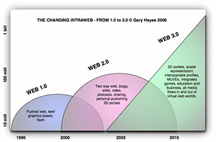
Henry Jenkins + Peter Ludlow
MIT’s Henry Jenkins has a great interview with our Muckraker-in-Chief over at the Second Life Herald, Peter Ludlow (aka SL’s Urizenus Sklar). In fact, it’s the first part of a two-part interview, the second part of which should be coming tomorrow. [UPDATE: Read part two.] There’s great stuff here on the importance of “local” or “community” journalism to virtual worlds. Tomorrow we’ll hear from Peter on the current debate that’s raging over Second Life, and more on governance in virtual worlds. Recommended reading. [posted by Mark Wallace on 3pointD]
Posted by jo at 06:03 PM | Comments (0)
Second Life

Energy Consumption of an Avatar
From Energy Consumption of an Avatar in Second Life: He quotes Philip Rosedale, the head of Linden Lab, the company behind the virtual world: "We're running at full power all the time, so we consume an enormous amount of electrical power in co-location facilities [where they house their 4,000 server computers]. We're running out of power for the square feet of rack space that we've got machines in. We can't for example use [blade] servers right now because they would simply require more electricity than you could get for the floor space they occupy."
If there are on average between 10,000 and 15,000 avatars "living" in Second Life at any point, that means the world has a population of about 12,500. Supporting those 12,500 avatars requires 4,000 servers as well as the 12,500 PCs the avatars' physical alter egos are using. Conservatively, a PC consumes 120 watts and a server consumes 200 watts. Throw in another 50 watts per server for data-center air conditioning. So, on a daily basis, overall Second Life power consumption equals:
(4,000 x 250 x 24) + (12,500 x 120 x 24) = 60,000,000 watt-hours
or 60,000 kilowatt-hours
Per capita, that's:
60,000 / 12,500 = 4.8 kWh
Which, annualized, gives us 1,752 kWh. So an avatar consumes 1,752 kWh per year. By comparison, the average human, on a worldwide basis, consumes 2,436 kWh per year. So there you have it: an avatar consumes a bit less energy than a real person, though they're in the same ballpark.
<...>
UPDATE: In a comment on this post, Sun's Dave Douglas takes the calculations another step, translating electricity consumption into CO2 emissions. (Carbon dioxide, he notes, "is the most prevalent greenhouse gas from the production of electricity.") He writes: "looking at CO2 production, 1,752 kWH/year per avatar is about 1.17 tons of CO2. That's the equivalent of driving an SUV around 2,300 miles (or a Prius around 4,000)." [posted by Felix Stalder on nettime]
Posted by jo at 08:48 AM | Comments (0)
January 31, 2007
Hazardous:
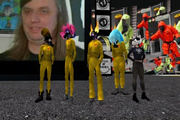
Second Front watches "Strange Culture"
This week we were invited to attend the premiere of "Strange Culture", an independent film by Lynn Hershman which discusses the infamous case of the arrest and pending trial of Steve Kurtz from the Critical Art Ensemble. The film will be shown at the Sundance Film Festival this week and has the distinction of being the first-ever feature film shown in Second Life.
It seemed altogether appropriate to have the first-ever performance art group in Second Life present at opening night (afternoon). We decided to don hazmat suits and gas masks to show our support for the defense in the ongoing Kurtz case. Second Front was unusually subdued in its urge to create a large-scale performance. We sat quietly and watched the film. The only sound besides the movie soundtrack was the constant clicking of the Second Life cameras as we documented this historic event.
Watching a movie in Second Life was totally weird. When you get to the movie theater, you hit the play movie control on your SL window. We're all watching the same film, but a different times! That seems like the most significant difference from a traditional cinema. Continue reading Hazardous: Second Front watches "Strange Culture" by Great Escape, Second Front.
Posted by jo at 01:00 PM | Comments (0)
January 26, 2007
The Girlfriend Experience

Multi-Player Game with Avatars of Flesh and Blood
The Girlfriend Experience: Multi-player game with avatars of flesh and blood 26 :: Jan 07-9 Mar :: Opening: Friday 26 January at 20:00 :: Mediamatic: Oosterdokskade 5, Amsterdam :: T 020 638 9901.
Martin Butler presents four human avatars to play with. Log in at home with your character of choice. Direct the avatar, explore the space and challenge him or her. The avatars can also be observed live in their Analog Villa. The avatars of The Girlfriend Experience will be available every Wednesday, Thursday and Friday from 20:00- 23:00. They can also be observed live in the Analog Villa, the Mediamatic Exhibition space.
The rampant growth of online avatar communities such as Second Life and World of Warcraft has enabled the creation of a personal online social and economic existence. Simultaneously this triggers inherent questions about this existence, as it questions what the consequences will be for first life, or reality.
When you use virtual avatars you can do as you please. In The Girlfriend Experience you will have to get to know each other first. Player and avatar explore what they can do for each other and how far the avatar wants to go to execute specific desires. It is ambiguous who is really controlling the situation. You have ten minutes to figure out what you can do with your avatar. After that, your time is up and another player can take your place.
The title of the project, The Girlfriend Experience, denotes the paradoxical character that online social interaction has. On one hand, the safe anonymity by using the avatar, on the other the intimate releases and projections that can spread easily. For Martin Butler is this the merging of two apparent extremes, anonymity and intimacy, which characterizes an important part of contemporary social traffic. The best paid prostitutes are the ones with whom the client feels as though he is with his girlfriend, or with whom he has a Girlfriend Experience.
related items:
www.liminalinstitute.nl [via netbehaviour]
Posted by jo at 11:32 AM | Comments (0)
January 23, 2007
Border Art
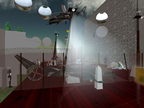
Imaging Place SL: U.S./Mexico Border
This article will attempt to filter (interpret?) for you a performance and installation in Second Life. The event was ‘a realtime interpretive and site-specific performance’ based on and for the opening of JC Fremont’s installation on borders: ‘Imaging Place SL: U.S./Mexico Border’. Second Front conceived and performed a wild experience on Friday 5th Jan at Ars Virtua (Gallery 2)...
...As I have considered before, art in SL and a virtual world cannot be executed or experienced in the same manner as our first life. An example of the discontinuity (or emergence of a new form of experience) is the avatar representation of ourselves in the art space. When in a gallery or at a performance purely in our first life, we can have some control over our expression. Our body expresses how we are feeling or what we are thinking. In a virtual world we have to script that expression. But when experiencing a piece of art we are usually quite immersed, putting all our concentration into that experience. To script a reaction feels like a performance. Indeed, I’m not saying that people who experience art in real life do not perform their experience of it, but what I find interesting in pieces of artwork like Fremont’s, is that I immediately feel terribly over-dressed and that I am acting inappropriately. For instance, this image is of a grandmother crying because she is seeing her grand-daughter for the first time through the border fence. And there I am (Lythe is), suddenly present in their world thanks to Fremont’s 360 nodes, with my bling and pretty smile..." From Border Art by Lythe Witte.
Posted by jo at 03:12 PM | Comments (0)
January 18, 2007
Second Life Left Unity
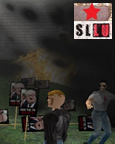
Real Life Fascist Group Recruiting Inworld
"While [Second Life Left Unity] SLLU welcomes the decision of the [Front National] FN to move from Porcupine, this has been to the detriment of the residents of Axel (another PG area). It has broken their peace and tranquility. This fascist group – one so abhorrent that the mainstream conservative party in France urged its supporters to vote socialist in order to ensure the FN didn’t reach any where near to victory in their last elections – has set up recruiting in world. This group is a RL fascist group with links to the very founders of fascism.
SLLU, also condemn this racist party for using SL as a place to recruit - the dissemination of discrimatory racist hate propaganda should be viewed as a violation of SL's community standards' We call on Axel residents to complain about this cabal and their sullying of the tranquil and beautiful area that was once Axel, and join our campaign to rid SL of racism. SLLU support residents in their wish to rid themselves of this group and the protests that have followed. SLLU can promise residents that our organization has no want to stay in Axel any longer than it takes to rid residents of the FN (who are at present trying to buy more Axel land). We reiterate our call on the Lindens to ban this group from PG areas." [via SLLU]
Posted by jo at 04:22 PM | Comments (0)
January 16, 2007
WhisperBox
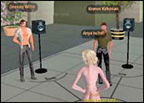
Interactive Sound Installation in Second Life
Second Life, one of the most populated MMORPG, is an important watching point to verify how the borderline between real and virtual tends to become more and more ephemeral. In the last months Second Life has seen many famous names and brands of the real world coming into its virtual spaces. The Reuters news agency has opened a virtual editorial office, IBM decided to test here its v-business (virtual business) idea. Many other events as lectures, talks (Lawrence Lessig), concerts (Suzanne Vega) has packed the SL dwellers agenda. So an interactive audio installation couldn't be missed. A certain Robbie Dingo (this is the name of the homonymous British sound designer avatar) programmed his WhisperBox (a 21st Century Folk Song).
The installation, hosted by the SL Phoenicia Center for Contemporary Art, captures words and pieces of the conversations that happens amongs the avatars inside its space (a circular space marked off by seven speakers) and translate these pieces in sounds. Tones and rhythms are directly influenced by the conversation progress. Furthermore WhisperBox provides also a visualization form of the spoken words, appearing near each avatar in a sort of 3D balloon. The displayed text then is an echo of the previous conversations. Clicking on different avatars with active balloons, their spoken words are played as music, and the previous conversations are immortalized, in a sort of inextricable and synaesthetic loop, made out of real and virtual, present and past, expression and representation." Vito Campanelli, Neural.
Posted by jo at 10:15 AM | Comments (0)
January 05, 2007
Second Life Sketches:

Two Worlds - Fame and Infamy
"...Ailin Graef operates in-world as Anshe Chung, the oft-touted first paper millionaire produced by Second Life. She’s a SL property magnate, and has recently begun tasting real-world fame, cover-featured on magazines and the like. It plays into Perception One, that new entrepreneurial ground has been broken and Second Life is the new field of 21st century capitalist enterprise.
It’s a good story, and the notion of presenting a digital avatar as a business celebrity has an appealing frisson of The Future to many. Recently, she agreed to an in-world interview with a CNET journalist. The interview was broken up by a group who caused a rain of giant penises to plunge down on the stage, helpfully recording their stunt in screenshots and video for the “Second Life Safari” section of the website Something Awful. The Second Life Safari team come from Perception Two, and they see something worth mocking in a publicity-conscious magnate who controls land parcels where people pretend to have illicit sex..." From Second Life Sketches: Two Worlds - Fame and Infamy by Warren Ellis, Reuters SL. Video.
Posted by jo at 01:57 PM | Comments (0)
December 29, 2006
ALL SIMS CONSIDERED
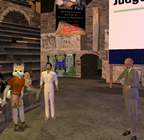
"Visiting the 'Second Life' World: Virtual Hype?"
I made a brief appearance on yesterday's "All Things Considered" from National Public Radio, in a story appropriately titled: "Visiting the 'Second Life' World: Virtual Hype?" (Yes, NPR has joined that particular debate, following Clay Shirky in casting deep skepticism on the "two million Residents" meme that the media is usually complicit in. But not this time.) Nicely reported by Laura Sydell, the segment actually devotes most of its coverage to Judge Posner's recent in-world appearance, and his Honor himself arrives to offer some trenchant thoughts on the importance of online worlds. Last year's NWN book club guest Thomas P.M. Barnett also shows up to praise the longtail power of his own appearance in-world. (Forseti Svarog of The Electric Sheep is on hand, too.) Taken together, it almost plays like an audio version of my GigaGamez essay on the hype and hope around Second Life.
Also, the raccoon. Fittingly, the raccoon lawyer shows up first. Listen to it all here. [blogged by W. James Au on New World Notes]
Posted by jo at 11:28 AM | Comments (0)
December 22, 2006
New World Notes

Gwyneth Llewelyn and the Kuurian Expedition
"...The analogy of “TV vs. theater” was thrown in for discussion— WoW and Everquest are more like TV, where the content is fed to the consumers. Second Life is more like a theatre, especially the ones presenting “interactive performances” where actors meet the public and there is a thin line separating both. Poinky comments: “It's a lot easier to watch TV thanto go a theatre.” This would explain the incredible commercial successes of WoW or EQ.
Interestingly enough, they tend to agree that you need some creativity to be able to enjoy SL.
Grace: “If you are not open to thinking creatively, SL might not be for you.” Frank and Poinky: “What I believe [is]we should define what is creative and what is naive creativity... Here everyone makes different fashions or architectures, by just right-clicking on the target, [hitting] a few buttons, and then move on, but it does not mean they are all interesting because they are original.” ..." From Gwyneth Llewelyn and the Kuurian Expedition by W. James Au.
Posted by jo at 06:45 PM | Comments (0)
December 14, 2006
Second Life

Clay Calls "Bullshit" on Second Life
Clay Shirky demands to see Second Life's hand in a recent article on Valleywag that calls bullshit on the virtual environment's numbers - and the crazy press coverage it's been getting lately.
I've always said there was something over the top about the whole Second life thing. I know it's a media darling right now, but how many people actually play it? And for how long?
When Clay writes, "I have been watching the press reaction to Second Life with increasing confusion" he mirrors my reaction. With every huge article in Businessweek the hype tree grew taller and bore ever more verdant leaves, seeding other articles in other publications. (I don't mean to call out Businessweek except that they published the most outrageous "Virtual Millionaire" article recently.) And while, yes, money in virtual economies is real, as Julian and Ted Catronova have shown (among others), how real is the money in a good if you hold all the goods yourself? It's only worth as much as others will pay for it and frankly, I'm just not sure that a userbase exists that *will* pay, collectively, a million bucks for virtual real estate.
I respect what Second Life is, and I think some of the press is well-deserved. It is a concrete way to imagine what we used to call cyber-space. I just don't think there's anything close to a mass movement represented by its users - just really interesting new ideas. [posted by Jane on Game Girl Advance]
Posted by jo at 10:54 AM | Comments (0)
December 11, 2006
Second Life
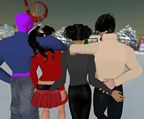
First Annual SL Literary Festival
First Annual SL Literary Festival :: Verum's Place, Yanguella :: December 16, 2006; 2:00 pm SLT :: Contact Carla Herrera, carla[at]contemporaryguide.com for more information.
Schedule of Events (Tentative/subject to change) :: Throughout the day there will be poetry readings, streaming music, discussions, art display, interactive literature projects, classes and workshops.
TBA: Patrick Lichty / Man Michinaga - Discussion: Digital Narrative and Online Spaces.
2:00 Opening ceremony Greetings & guest speaker on front lawn ::
3:00 Schedule of Workshops and Classes begin Signs and teleporters provided :: Workshops and classes run throughout the day and will conclude at 6:30 for fireworks And storytelling :: 4:00 Tours of the Gothsburg castle begin Tours last 30-45 minutes. :: 3:30 Open mic at Verum's place Essays & poetry welcome :: 4:00 Poetry Challenge $L100. to the winner :: 5:00 Tramp's Theatre Troupe Surprise performance :: 6:30 Fireworks By Spider :: 7:00 Storytelling circle on front lawn :: 8:00 Event close/Open chat/discussion.
Posted by jo at 04:25 PM | Comments (0)
December 07, 2006
Homeless kid in Second Life
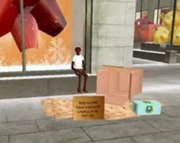
Help a child have a second oportunity in his First Life
Cory Doctorow: Alex sez, "From December 4 on, the Spain-based NGO Mensajeros de la Paz will be present in the virtual world of Second Life as a homeless teenager avatar named MensajerosDeLaPaz Jubilee. The kid hasn't any land nor properties, except for a cardboard box, some newspapers and a sign that says: 'Help a child have a second oportunity in his First Life.'"
"The action is intended to reach out for young people, and ask for help for abandoned and abused children in developing countries in South America and Africa," says Ana de la Calle, a communications representative of the organization.
"We think Second Life and other forms of new technologies can be a great way to connect with young people and make them a little more conscious about the huge population in the real world needing help, and it doesn't cost much to guarantee the future of another human being", says Salvador Dinez, art director of the ad agency ArnoldFuel and one of the designers of the project. The action also includes getting broadcasting online videos of the reaction of the Residents. Link [via Boing Boing]
Posted by jo at 08:30 AM | Comments (0)
danah boyd on "Creating culture through collective identity performance"

Technologies of Cooperation
My post about danah boyd's November 14 presentation is up at Annenberg Center's DIY Media blog (including a classic photo by Ross Mayfield of danah, Mimi Ito, and Justin Hall):
boyd pointed out that the personal profiles in social networking services provide "moments of representation of identity and digital body." What makes SNSs unique, boyd asserted, are features around friends and networks of friendship that articulate and make visible aspects of interpersonal relationships and social networks that have always existed, but not so visibly. The SNS feature enabling participants to create, display, and edit lists of friends online (e.g., "Top 8" in MySpace, friends lists in Facebook, Friendster, et. al.) presents young people with an opportunity to present their networks of social connections visibly to the world. "In MySpace," boyd noted, ""top 8" is like a high school drama -- who you tell the world your best friend is will get you in horrible trouble offline or online. Who do I put in the top left slot"? MySpace management realized that this feature attracted attention, so they sold as a premium what had been a misfeature in their original design, charging to have more than 8 friends.
Comments on Friendster evolved beyond Friendster-like testimonials. "It became a way of speaking to and about someone and about yourself in the process. Making sure everyone else knows that they are in your list of friends solicits reciprocity. "
This identity-play and social experimentation is a form of DIY media, boyd pointed out, because in social network services, social rituals and norms are signalled by online representations like graphical backgrounds and friend lists, displays of cultural consumption (playlists and fashions) and cultural production (photos, photostreams, and videos). [blogged by howard on Smart Mobs]
Posted by jo at 08:20 AM | Comments (0)
November 25, 2006
Second Life: The Official Guide

Second Life Gets a Paper Book
Second Life has been on Techmeme a lot lately. Most of this has been about the continuing inroads that larger companies like Dell and Reuters have made into the world. Some of it has been about strife within the world due to things like land price increases and copybot (a recently released program that can copy any artifact in world; BoingBoing has a good piece discussing the issues).
The latest splash is a physical book, entitled Second Life: The Official Guide, that is now available on Amazon. As the documentation for the world moves off the web it becomes more accessible and even *more* people will join.
"Second Life: The Official Guide is the perfect book for anyone interested in Linden Lab’s fascinating Second Life metaverse. It explores in detail every aspect of Second Life’s rich and multilayered virtual world, explains how it works, and offers a wealth of information and practical advice for all Second Life residents. The first part, “Getting a Second Life,” acquaints potential and new players with the Second Life world. It describes the metaverse’s geography as well as its society, explaining its written and unwritten rules. The second part, “Living a Second Life,” deals with the practical and economic aspects of Second Life: creating and customizing an avatar, building objects, scripting, and making money. The third part of the book, “Success in Second Life,” discusses ways to enjoy Second Life more. It includes profiles of successful Second Life residents, discusses fascinating in-world events, and examines how some are using Second Life for business, training, and other purposes. The book closes with a glossary as well as quick-reference and additional-resources appendices. The book's CD includes special animations, character templates, and textures created by Linden Lab exclusively for this book. The disc also guides new users through the installation and includes a code that grants a special object the first time they enter the metaverse." [blogged by Brad Forrest on O'Reilly Radar]
Posted by jo at 04:26 PM | Comments (0)
Second Life Copybot
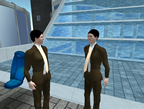
Investing Time and Money in Virtual Worlds
"In the last month something happened that shook the world to its core. It was the sudden appearance of the capability to instantly replicate three-dimensional objects, suddenly in the hands of the common people. Everyone’s intellectual property was up for grabs, and the very notion of manufacturing under attack. Small business owners who relied on handcrafting luxury goods found themselves completely vulnerable to perfect knockoffs...
Microtransactions for digital assets and virtual goods is a rising, potentially multibillion dollar industry. To succeed, entrepreneurs who are building networked systems based on user content (be they citizens of Second Life or the makers of virtual worlds themselves) must realize that anything displayable is copyable; the value lies instead in service and in server-side functionality. Content is like songs around a campfire: destined to be enjoyed for free. Those who build businesses around hosting campfires would be wise to focus on making the campfire experience great, rather than charging listeners by the song." From Investing time and money in virtual worlds: Caveat Emptor by Raph Koster, Venture Beat. [via]
Also:
"...[Linden Lab] plans to develop an infrastructure to enable Second Life residents and landowners to enforce IP-related covenants within certain areas, or as a prerequisite for joining certain groups. In effect, Second Life's inhabitants will self-police their world, according to rules and social norms they develop themselves." From Second Life Will Save Copyright by Jennifer Granick, Wired.
Posted by jo at 04:16 PM | Comments (0)
November 16, 2006
Second Life
COPYING A CONTROVERSY
"...The hack suggested a way of finally introducing AIs and non-player characters into the world, creating endless possibilities for game development, simulation, and more, but that wasn’t even the coolest part. Because not only had they figured out a way of introducing artificial avatars, they’d also hacked up a way of cloning existing avatars, clothes included. Not just one or two clones, but over a dozen, dropping out of the sky like godspawn.
Edited in double-time, this video demonstration features me, Talila Liu, and Gwyneth Llewelyn and our several dozen doppelgangers..." From COPYING A CONTROVERSY (Updated) [blogged by W. James Au on New World Notes]
Posted by jo at 07:31 PM | Comments (0)
Second Life

Businesses Close Due to Cloning
Copybot is a program designed to clone other people’s SL possessions. When someone sells an item in SL, they naturally have the option to limit what the purchaser does with it. People creating unique designs as a business enterprise don’t always want you to be able to issue infinite copies for free, after all.
The night before last, I was looking around a no-fire combat sandbox, where people design and test weapons and vehicles, when an argument broke out; a thing going by the name Nimrod Yaffle was cloning things out of other people’s inventories, and claiming he could freely do it because he’d been playing with Copybot with employees of SL creator/operators Linden Lab. All hell broke loose, in the sort of drama you can only find on the internet. Linden Lab’s first official response? If you feel your IP has been compromised by Copybot, we’ll sort of help you lodge a DMCA complaint in the US. Businesses started shutting down moments later. [posted by Warren Ellis on This Is The Warren Ellis Dot Com]
"Second Life needs features to provide more information about assets and the results of copying them. Unfortunately, these are not yet in place. Until they are, the use of CopyBot or any other external application to make unauthorized duplicates within Second Life will be treated as a violation of Section 4.2 of the Second Life Terms of Service and may result in your account(s) being banned from Second Life. If you feel that someone has used CopyBot to make an infringing copy of your content, please file an abuse report. Note that this is completely separate from any copyright infringement claim you may wish to pursue via the DMCA.
Like the World Wide Web, it will never be possible to prevent data that is drawn on your screen from being copied. While Linden Lab could get into an arms race with residents in an attempt to stop this copying, those attempts would surely fail and could harm legitimate projects within Second Life." Continue reading Use of CopyBot and Similar Tools a ToS Violation.
[posted by marc garrett on netbehaviour]
Copybot Protest:
Second Life, Economic Evolution and the CopyBot
"...If the ability to make copies continues to exist, these vendors argue, the basis of the SL economy will be destroyed. And since there's a direct conversion between in-game money and real-world money, anything that weakens the SL economy threatens the real-world economic livelihoods of many SL residents. They're right -- but is the Second Life economy worth saving?
What Linden Lab has tried to do is replicate the atom-world scarcity rules in a bit-world environment. Nobody should be surprised in any way that this doesn't work for long. It is the nature of bits to be easily copied. Even if Linden manages to shut down CopyBot, it will arise again in another form, and probably as something much harder to squelch. The death of Napster becomes the explosion of Gnutella and Bit Torrent; the death of CopyBot will mean the emergence of something more powerful and less easily eliminated. It's delightfully Darwinian..." From Second Life, Economic Evolution and the CopyBot, Open the Future]
Posted by jo at 06:39 PM | Comments (0)
November 10, 2006
RootsCampSL

LAYING DOWN ROOTS
[image: Frobozz and Glitter] Netroots move into the metaverse. Inspired by BarCamp, the ad-hoc open conference system, RootsCamp merges that format with Net-driven political activism with a left-of-center bent. Perfectly timed to launch in the wake of the mid-term elections, the group will hold regular events in Second Life every day for the next week, starting tomorrow at 1pm SLT. Unsurprisingly, they'll start with a de-brief on the elections which just brought the Democrats back in control of Congress.
It's another example of metaverse-based political activism, following a path laid by Governor Mark Warner, and others before him. "RootsCampSL is an effort to allow people that can't make it to a physical offline RootsCamp," co-host Drew Frobozz explains, "to still be able to participate in one, and also to get the progressive Netroots up to speed with Second Life-- which we believe will be an important political organizing platform for the 2008 election." I've previously speculated on Second Life's potential to become a virtual meet-up platform, but given the real life activist background of Drew Frobozz (here) and his co-organizer Ruby Glitter (here), I'm inclined to take that statement far more seriously, coming from them.
RootsCampSL main page is here, Thursday's 1pm event listing is here. [blogged by W. James Au on New World Notes]
Posted by jo at 04:20 PM | Comments (0)
June 05, 2006
Is MySpace a Place?
![]()
spatial nature of MySpace
Networked Performance pointed me toward an interview (download in PDF) with Networked Publics speaker Henry Jenkins and Networked Publics friend danah boyd about Myspace. The site, popular with teenagers, has become increasingly controversial as parents and the press raise concerns about the openness of information on the site and the vulnerability this supposedly poses to predators (Henry points out that only .1% of abductions are by strangers) and the behavior of teens towards each other (certainly nothing new, only now in persistent form). In another essay on Identity Production in Networked Culture, danah suggests that Myspace is popular not only because the technology makes new forms of interaction possible, but because older hang-outs such as the mall and the convenience store are prohibiting teens from congregating and roller rinks and burger joints are disappearing.
This begs the question, is Myspace media or is it space? Architecture theorists have long had this thorn in their side. "This will kill that," wrote Victor Hugo with respect to the book and the building. In the early 1990s, concern about a dwindling public culture and the character of late twentieth century urban space led us to investigate Jürgen Habermas's idea of the public sphere. But the public sphere, for Habermas is a forum, something that, for the most part, emerges in media and in the institutions of the state:
The bourgeois public sphere may be conceived above all as the sphere of private people come together as a public; they soon claimed the public sphere regulated from above against the public authorities themselves, to engage them in a debate over the general rules governing relations in the basically privatized but publicly relevant sphere of commodity exchange and social labor. The medium of this political confrontation was peculiar and without historical precedent: people's public use of their reason (öffentliches Räsonnement). In our [German] usage this term (i.e., Räsonnement unmistakable preserves the polemical nuances of both sides: simultaneously the invocation of reason and its disdainful disparagement as merely malcontent griping. (Habermas, 27)
Nevertheless, the salon, the café, and the parliament were key places that instituted this kind of discourse, and they succeeded the court, which was explicitly spatial.
But Myspace and the new sites of network culture are different from the media of old. If they are—in general—not places of rational discourse, they are venues in which publics gather. Is Myspace media? Yes. Is it a place, maybe? In my book, MMORPGs such as World of Warcraft definitely are. So do we exclude myspace just because it is not rendered in three dimensions? Are spaces media themselves? Are media spaces? Could be (think of the Seattle Public Library). I don't have any easy answers on this, even as Anne Friedberg and I work on our essay for the upcoming Networked Publics book.
[blogged by Kazys Varnelis on Networked Publics]
Comment by danah boyd:
spatial nature of MySpace
Over on Networked Publics, Kazys Vernelis asked Is MySpace a Place? I wrote a comment in response that others might find interesting. (And perhaps prompt folks like Anne to put me in my place.)
I would argue that MySpace is a 'place' in that it's a locatable site that people "go to" and it has structural walls regulated through being logged in, being inside the domain, etc. But I would argue that this is not that important. Instead, I would focus on how MySpace is an 'imagined space' (stretching Anderson's 'imagined communities') where the space is framed by the perceived rituals, norms and acts that constitute MySpace participation. [I would also argue that MySpace is a 'medium' in a McLuhan sense because of its role in 'extending man' into the virtual for social engagement. In this way, participation might destroy the platial nature of MySpace by letting people participate in imagined communities where MySpace is simply a channel through which communication and performance occur. But it does not destroy the spatiality invoked.]
I think things get confused by bringing Habermas into the fold because his definition of spatiality is rooted in the public sphere which is entirely framed by discursive engagement. He sees identity as constructed in private such that the public sphere is the gathering of private individuals for the purpose of verbalized communication. Nancy Fraser is useful in this way because she argues that a core component of publics is the way they allow individuals to negotiate identity. Pulling in Goffman in response to Fraser, spatiality is constructed by shared situationalism through which impression management can take place.
This is where I end up talking about 'digital publics' because the nature of public life in a new networked age relies on architectural properties not normally present in (unmediated) social life - persistence, searchability, replicability, invisible audiences. While we can turn to celebrity culture and mass media's role in collapsing contexts (Meyrowitz) to get a grasp on what's going on, negotiating these types of publics is new for most people. Digital publics are tricky because they rely on a networked structure, not a group structure dictated by audience or location. The same turn that complicates digital publics complicates issues of spatiality. In short, what are the boundaries? This is why i'd argue that it's an 'imagined space' instead of a space as we normally conceptualize it.
[How terribly am I misreading theoretical ideas of space and place?] [blogged by danah on apophenia]
Posted by jo at 11:12 AM | Comments (0)

